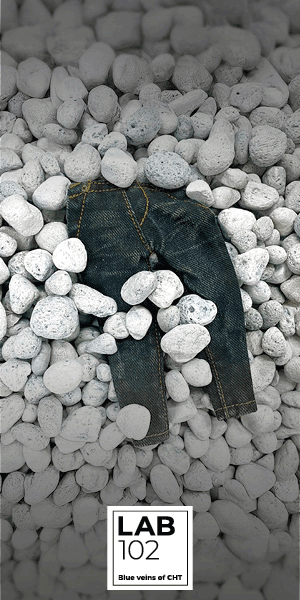Anne Oudard: Beware #covidwashing on jeans

The French designer would love to see the end of oil-based material in the denim industry, wishes cotton supply chains were more transparent and wonders if antimicrobial finishes are really combatting dirt in the way consumers assume.
What has been the biggest change for your business or way of working since the pandemic started?
During the first month of lockdown, when everything stopped, my workload dropped drastically and after a short moment of astonishment I got super busy with all the online talks and events.
It was amazing to attend to all these conversations from my living room! This really helped me stay busy and focus on my job. I also enjoyed being able to take time for reading books and reports about denim and sustainability. Looking back at these last months, I realise how lucky I’ve been to be able to dive deeper into topics like circular economy, recycling, biodegradability… It’s literally like I went back to school! Now that my days are back to a more normal schedule I’m trying to keep "reading times" on my agenda. The denim industry is so dynamic and fascinating!
Do you think antimicrobial finishes, or higher levels of ‘performance’, might gain in popularity?
Performance always makes great marketing content. Antimicrobial finishes have been coming and going for a while now and in this context of a worldwide pandemic it’s no surprise to see them finally flourishing.
To be honest, I do suspect this to be just another opportunity of selling new products rather than a genuine solution to the sanitary crisis. Firstly, because the name antimicrobial usually means antibacterial and not ‘antiviral’ (bacteria and viruses being different types of microbes).
Most antibacterial finishes are aimed at controlling the smell of our clothes and therefore reduce their washing frequency, which is great for water and energy saving. On the downside, I wonder, if these finishes kill bacteria, do they also kill the healthy ones living on our skin? And what are the consequences when they leak into wastewater, rivers and oceans?
If we were considering the biodegradability of natural fibres, the antimicrobial properties of the fabric would completely impede the process and kill the microbes in charge of decomposing the organic material. Maybe we should just remember that some fibres, like hemp, have natural antibacterial properties.
And if some antimicrobial finishes might be efficient against viruses, I would rather use them for face masks than for jeans. I don’t think our legs can get infected… Should we just call that #covidwashing?
What are you proudest of? What interests you the most?
I’m really proud of being a freelance designer. It’s never been an easy road. I started working 10 years ago when times were already pretty rough! I never had it easy, a couple of times I’ve had to take a side job to pay for my rent but I never felt like giving up. The denim community has been so welcoming and supportive, I’m very glad to be doing this job today.
Despite all the crises (or maybe thanks to them) it is a great time to work in denim. I am so excited to be part of such an innovative industry, there’s a lot going on, good and bad, and it’s making it quite fascinating. The challenge of making the best jeans has given my job a real purpose and led my interest towards chemistry, agriculture, biomaterial… There’s so much to reconsider and to redesign!
What are your thoughts on the certification processes? Do you think there are too many or are they all necessary?
So far I think third-party certificates are the safer way to make sure you’re working with the right products and the right partners. They are controversies and certifications aren’t perfect. One should never blindly rely on them. We’ve realised how crucial it is to know who’s making your clothes and how. Visiting your suppliers and asking them questions about their practices remains important, yet most certifications can be of great help.
At first they might seem to be many but sustainability is wide and each company has a different vision of what it means. When looking closely at the main certifications it’s easy to realise they just cover different parts of the chain (organic fibres, recycled content, chemical, ethical practices, fair wage etc). Each category is complex and it’s probably best that they are handled by experts. When several of them cover the same topic, competition drives them to be better. Of course, this means we have to look into what they do but once again, that’s for the best.
What will the consumers be looking for in the future, how will this affect design?
I’d like to first mention that I am talking from a European perspective and as a designer who mostly works for small to medium brands with strong ethical and environmental values. That being said, I see ‘my’ customers looking for honest, valuable products. They want good products at a fair price. Their purchases are well thought, they answer a durable need and must provide them with great satisfaction.
In the past few years, my designs have been shifting from seasonal, trend-driven styles to more « ‘timeless’ pieces. I have become a lot more picky on my fabric selection, aside from environmental concerns around the fibres, I have to make sure of the durability of the denim I use. Wash treatments are also considered with the same perspective. Then the fit needs to feel absolutely fantastic if you want to enable your customer to keep wearing the jeans for years.
Finally, designing a long-lasting pair of jeans doesn’t mean it should be boring! I like to give a very special attention to that perfect detail that will make you fall in love. It could be a colour accent on a buttonhole or a print on the pocket bag. The idea is to create an emotional bond between the jeans and the person who wears them.
In terms of fibres and materials, what would you like to see happen in the next five years?
Can I make three wishes?
First, I’d like to see more transparency on cotton, more traceability. I love cotton but depending on where and how it’s grown, it can either be the best or the worst fibre. Mills tend to be super secretive about their cotton suppliers, sometimes I even wonder if they really know where it is from. I really want to see the light shed on cotton provenance.
My second wish would be that recycled content would be systematically integrated in the yarn composition. All mills should hop on the ‘zero-waste’ wagon and reuse every bit of fabric, yarn or fibre lost in the process. It’s for their best interest.
And for my third wish, I would like to completely eliminate oil-based material from the denim industry. Polyester (virgin and recycled) is causing uncontrollable damage to our planet. And if that doesn’t choke you enough, it is intoxicating us via the air we breathe, the water we drink and the food we eat. I understand that for some product categories, polyester can still be relevant but I don’t think the denim industry needs it. Instead, I would like to see the rise of a wider range of natural fibres, bio-materials and 100% plant-based stretch.
Anne Oudard is a French denim designer. She consults for brands, designing and developing their denim collections. Anne specialises in environmentally and socially conscious developments. She works exclusively with organic, recycled and reclaimed materials as well as local manufacturers. Besides from having worked for 10 years with the denim agency Monsieur-T, she’s assisted designers like Faustine Steinmetz and Casely-Hayford. She’s now in charge of the denim line for the Parisian brand Patine and is collaborating with upcoming labels, launching this winter.













